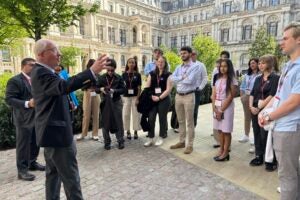AUSTIN, Texas—A University of Texas at Austin engineering professor is working with a $2.94 million grant from the National Science Foundation aimed at minimizing loss of life and structural damage from earthquakes.
Dr. Kenneth H. Stokoe II is principal investigator on a project to design a new generation of equipment that is used to perform earthquake studies in the field. It literally is ground shaking work that will provide the basis for better predictions on how soil interacts with buildings, bridges, highway overpasses and homes. The goal is to develop structures better able to survive major quakes.
“Engineering has saved many lives,” Stokoe said. “A good example of what we are doing is the Olympia (Washington) earthquake. It was a 6.8 (magnitude quake), but there was no loss of life. That’s the whole idea.”
Stokoe’s grant is among 11 awards totalling $45 million recently announced by the NSF to fund experimental equipment that can be shared nationwide to study earthquake effects. The initiative involves Internet collaboration among researchers and engineers from New York to California.
“The past decade has seen immense devastation from major earthquakes around the world,” said Priscilla Nelson, NSF division director for civil and mechanical systems. “We can’t control the destructive forces of nature. But this equipment can help us design and construct buildings, bridges and other structures that can better withstand those forces.”
Stokoe is the Jennie C. and Milton T. Graves Chair in Engineering. He is working with two co-principal investigators, Dr. Ellen M. Rathje, an assistant professor in the department of civil engineering, and Dr. Clark R. Wilson, a professor in the department of geological sciences. Wilson is the Wallace E. Pratt Professor in Geophysics.
The quake simulation equipment used by these researchers literally causes the ground to rock and roll, at least in a small area near the machinery.
Stokoe, who travels throughout the world to study the effects of quakes, explained that his work centers in part on equipment called shakers. One is actually a vehicle, called a “vibroseis,” that resembles a semi truck. It has tires six-feet-high and weighs 65,000 pounds. The machine originally was used by oil companies in the seismic search for petroleum deposits.
“It is a powerful shaker that shakes the ground vertically or horizontally. We can create earthquake-level shaking around the vehicle. We can exceed the strength of the Seattle quake æ but only in the area immediately next to the shaker,” Stokoe said. “The other shakers are cubicle shakers that can shake soil or pavement or bridges or buildings. These shakers are in the shape of cubes so that they can be oriented in any direction.
“This represents the next generation of equipment for testing in the field. We’ll do things with this equipment that have never been done before,” Stokoe said. “And we’ll be investigating soils to find out where it’s more advantageous to build and where it’s more difficult. Because of all the effort that has gone into earthquake engineering, we’re saving more and more lives.”
NSF plans to spend up to a total of $81.9 million by 2004 to enhance earthquake engineering research equipment in the United States and to build a high performance Internet network to connect the equipment facilities. The current equipment awards total $45 million over four years. The money goes to 10 universities to fund construction, expansion and modernization of equipment, including shakers to simulate earthquakes, centrifuges, a tsunami wave basin, large-scale laboratory experimentation systems, plus field experimentation and monitoring installations. All equipment is expected to be operational by late 2004.
Stokoe teaches in the UT Austin department of civil engineering. He has worked in the areas of field seismic measurements, laboratory measurements of dynamic material properties and dynamic soil-structure interaction for the past 30 years. He has done many studies focusing on soils, pavement surfaces and airport runways, including work at Dallas-Fort Worth (DFW) Airport and various highway pavement studies in Houston, Waco and Dallas.
Rathje has been on NSF-sponsored reconnaissance teams visiting Turkey after both recent earthquakes. She recently returned from a post-quake reconnaissance visit to India. Wilson is a professor of geophysics who brings more than 25 years of experience in exploration geophysics, digital data processing and geodesy to the research team.
The NSF awards are part of the George E. Brown, Jr. Network for Earthquake Engineering Simulation. The program was renamed in November 2000 by an Act of Congress to honor the late George E. Brown Jr., former chairman of the House Science Committee and a champion of engineering and science in Congress for more than 30 years.
For more information, contact: Becky Rische at (512) 471-7272, Dr. Kenneth Stokoe at (512) 471-4929, or Amber Jones at the National Science Foundation at (703) 292-8070. The NSF Web site is: www.ce.utexas.edu/prof/stokoe/home.html



